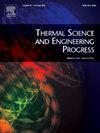Moving boundary modeling during drying with intermittent microwave: The effect of pulse ratio
IF 5.4
3区 工程技术
Q2 ENERGY & FUELS
引用次数: 0
Abstract
Incorporating a moving boundary to represent shrinkage is vital in modeling transfer phenomena during drying. Lately, intermittent microwave drying has gained significant popularity due to its ability to produce superior dried food products. According to current literature, the simulation of pulsed microwave and its effect on coupled electromagnetic, moisture, and temperature distributions during combined drying with hot air using a moving boundary has not yet been investigated. This research examined various microwave pulse ratios (1 [continuous], 2, 4, and 6) with a fixed off-time of 180 s and a power of 900 W, alongside the control treatment (hot air; HA). The final moisture content decreased by 18.89 % with the increase in pulse ratio from 1 to 6, due to the accelerated moisture removal. Shrinkage and apparent density of the samples also decreased as the pulse ratio increased, due to enhanced porosity. The rehydration capacity at the pulse ratio of 6 was higher by 6.28 %. Energy consumption also decreased significantly by 31.32 % as the pulse ratio increased. Simulation results showed that the electric field was higher in the interior parts of the product due to the volumetric heating by microwave radiation compared to the edges. In the joint microwave and hot-air drying technique, due to the microwave’s volumetric heating mechanism, the internal temperature was higher than the surface temperature. Overall, the results showed that higher pulse ratios could produce dried products of better quality. The modeling procedure may be employed to optimize the combined microwave and hot-air drying process.
间歇微波干燥过程的移动边界建模:脉冲比的影响
在模拟干燥过程中的转移现象时,结合移动边界来表示收缩是至关重要的。最近,间歇性微波干燥因其生产优质干燥食品的能力而获得了显著的普及。根据现有的文献,目前还没有研究脉冲微波的模拟及其对移动边界热风联合干燥过程中电磁、水分和温度耦合分布的影响。本研究检测了不同的微波脉冲比(1[连续],2,4和6),固定关闭时间为180 s,功率为900 W,以及控制处理(热空气;公顷)。随着脉冲比从1增加到6,最终含水率降低了18.89 %,这是由于加速了水分的去除。由于孔隙率的增加,样品的收缩率和表观密度也随着脉冲比的增加而降低。脉冲比为6时,复水能力提高了6.28 %。随着脉冲比的增大,能耗也显著降低了31.32 %。仿真结果表明,由于微波辐射的体积加热,产品内部的电场比边缘要大。在微波与热风联合干燥技术中,由于微波的体积加热机制,内部温度高于表面温度。综上所述,脉冲比越高,干燥产品的质量越好。该模型可用于微波与热风联合干燥工艺的优化。
本文章由计算机程序翻译,如有差异,请以英文原文为准。
求助全文
约1分钟内获得全文
求助全文
来源期刊

Thermal Science and Engineering Progress
Chemical Engineering-Fluid Flow and Transfer Processes
CiteScore
7.20
自引率
10.40%
发文量
327
审稿时长
41 days
期刊介绍:
Thermal Science and Engineering Progress (TSEP) publishes original, high-quality research articles that span activities ranging from fundamental scientific research and discussion of the more controversial thermodynamic theories, to developments in thermal engineering that are in many instances examples of the way scientists and engineers are addressing the challenges facing a growing population – smart cities and global warming – maximising thermodynamic efficiencies and minimising all heat losses. It is intended that these will be of current relevance and interest to industry, academia and other practitioners. It is evident that many specialised journals in thermal and, to some extent, in fluid disciplines tend to focus on topics that can be classified as fundamental in nature, or are ‘applied’ and near-market. Thermal Science and Engineering Progress will bridge the gap between these two areas, allowing authors to make an easy choice, should they or a journal editor feel that their papers are ‘out of scope’ when considering other journals. The range of topics covered by Thermal Science and Engineering Progress addresses the rapid rate of development being made in thermal transfer processes as they affect traditional fields, and important growth in the topical research areas of aerospace, thermal biological and medical systems, electronics and nano-technologies, renewable energy systems, food production (including agriculture), and the need to minimise man-made thermal impacts on climate change. Review articles on appropriate topics for TSEP are encouraged, although until TSEP is fully established, these will be limited in number. Before submitting such articles, please contact one of the Editors, or a member of the Editorial Advisory Board with an outline of your proposal and your expertise in the area of your review.
 求助内容:
求助内容: 应助结果提醒方式:
应助结果提醒方式:


